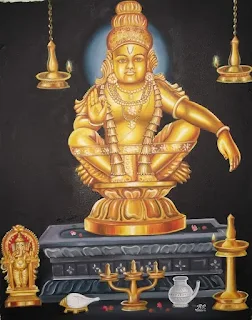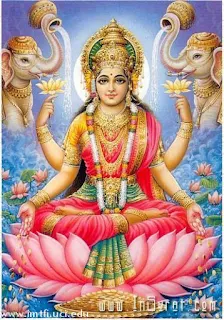In a small hill shrine popularly known as sahyadri hills a temple called sabarimala is situated and the presiding deity is lord Ayyappan or Lord Aiyappa.In the months from November 15th to January 15th millions of devotees from all over the world would visit Sabarimala.
Like in other temples devotees can walk in any day during puja or
offering timings.pilgrimage of sabarimala is undertaken after a strict 'Vrath'(austerities) for 41 days.Performing this 'Vrath' for 41 days purifies one's soul and brings him closer to God , it is also called 'Thatvamsi'- that is , oneness of God and self.And the period of vrath is also called as 'Mandala kaal'.After the 'Mandala Kall',devotees will undertake pilgrimage to the sabarimala temple(In Kerala).
The Legend and History Of Ayyappan
There was a king named Mahishasura , who had a boon that no men can destroy him and he was trying to destroy the world. He was blessed with invulnerability to all men, then the Gods sent a women , the Goddess Durga , to fight and kill him . Finally the goddess succeed in killing Mahishasura.
Mahishasura had a sister named Mahishi , Began performing a fearsome set of austerities, and breaked all records in grim tapasya , that Lord Brahma The creator had really no option but to give her the boon she wanted.The boon she asked , she can only be killed when both Lord Shiva and Lord Vishnu sterngth and powers are combined, Since such a person did not exist , she thought she was safe and other asuras started the plunder.
The gods then went to Lord Shiva and Lord Vishnu to save them from this catastrophe.Then Lord Vishnu comes out with a Possible solution.When Vishnu had taken kurma Avatar,he also had to manifest himself as Mohini,the enchantress,to save the nectar of immortality from the demons who are not willing to share it with the gods.Then Lord Vishnu thought if he became Mohini again,then the female Mohini and the male shiva could have the divine child who would combine their powers and beat Mahishi.Thus was born Lord Ayyappan.The divine child was left on the banks of Pampa River.There was a king named Rajasekhara in Panthalam(Kerala), who belongs to the pandya dynasty of south India,while hunting he heard the crying of the child found lying on the banks of the river,with a radiant face and a Golden bell tied around his neck.The King who had no child of his own,took him to the palace and brought him up as his own son.Then he was named Manikantha because of the Golden bell found around his neck.
After few years , the Queen also conceived and gave birth to a son.Both sons grew up in the palace as brothers.But when the time came to decide on who will be the prince,king Rajasekhara nominated Manikantha as the Prince(Yuvaraja).But due to the conspiracy of the chiefminister, the Queen favoured her own son.Then the Quuen and the chiefminister hatched a plan to get rid of Manikantha.She acted as she has got sickness and prevailed upon the palace physician to prescribe a Medicine which included the milk of a tigress.Manikantha was assigned to the task of milking the tigress and was sent out to the forest.It was the plan of the Queen that he would be killed by the wild animals in the process.
The King advised Manikanda to take along a coconut of tri-netra (three eyed coconut) to represent Shiva in order to protect him and some food items to sustain him till his return, in a cloth bundle known as irumudi which was to be carried upon his head.
While wandering in the forest of Sabari, the battle between Mahishi and Ayyappan took place at the bank of Azhutha.Finally Lord Ayyappan killed Mahishi.Mahishi's soul emrged and was redeemed from a curse that sustained from her previous life ,when she was known as Leela.She then requested Ayyappan to marry her and take her as his consort.But Lord Ayyappan declined being a celibate.How ever he promised that she also would be visited by piligrims and would be housed next to his temple, he promised that if the number of new pilgrims visiting him stopped,then he would marry her, But the number of pilgrims increases every year.
Harivarasanam is chanted by his devotees every day , which pleases Lord Ayyappan to grant boons for his devotees
Like in other temples devotees can walk in any day during puja or
offering timings.pilgrimage of sabarimala is undertaken after a strict 'Vrath'(austerities) for 41 days.Performing this 'Vrath' for 41 days purifies one's soul and brings him closer to God , it is also called 'Thatvamsi'- that is , oneness of God and self.And the period of vrath is also called as 'Mandala kaal'.After the 'Mandala Kall',devotees will undertake pilgrimage to the sabarimala temple(In Kerala).
The Legend and History Of Ayyappan
There was a king named Mahishasura , who had a boon that no men can destroy him and he was trying to destroy the world. He was blessed with invulnerability to all men, then the Gods sent a women , the Goddess Durga , to fight and kill him . Finally the goddess succeed in killing Mahishasura.
Mahishasura had a sister named Mahishi , Began performing a fearsome set of austerities, and breaked all records in grim tapasya , that Lord Brahma The creator had really no option but to give her the boon she wanted.The boon she asked , she can only be killed when both Lord Shiva and Lord Vishnu sterngth and powers are combined, Since such a person did not exist , she thought she was safe and other asuras started the plunder.
The gods then went to Lord Shiva and Lord Vishnu to save them from this catastrophe.Then Lord Vishnu comes out with a Possible solution.When Vishnu had taken kurma Avatar,he also had to manifest himself as Mohini,the enchantress,to save the nectar of immortality from the demons who are not willing to share it with the gods.Then Lord Vishnu thought if he became Mohini again,then the female Mohini and the male shiva could have the divine child who would combine their powers and beat Mahishi.Thus was born Lord Ayyappan.The divine child was left on the banks of Pampa River.There was a king named Rajasekhara in Panthalam(Kerala), who belongs to the pandya dynasty of south India,while hunting he heard the crying of the child found lying on the banks of the river,with a radiant face and a Golden bell tied around his neck.The King who had no child of his own,took him to the palace and brought him up as his own son.Then he was named Manikantha because of the Golden bell found around his neck.
After few years , the Queen also conceived and gave birth to a son.Both sons grew up in the palace as brothers.But when the time came to decide on who will be the prince,king Rajasekhara nominated Manikantha as the Prince(Yuvaraja).But due to the conspiracy of the chiefminister, the Queen favoured her own son.Then the Quuen and the chiefminister hatched a plan to get rid of Manikantha.She acted as she has got sickness and prevailed upon the palace physician to prescribe a Medicine which included the milk of a tigress.Manikantha was assigned to the task of milking the tigress and was sent out to the forest.It was the plan of the Queen that he would be killed by the wild animals in the process.
The King advised Manikanda to take along a coconut of tri-netra (three eyed coconut) to represent Shiva in order to protect him and some food items to sustain him till his return, in a cloth bundle known as irumudi which was to be carried upon his head.
While wandering in the forest of Sabari, the battle between Mahishi and Ayyappan took place at the bank of Azhutha.Finally Lord Ayyappan killed Mahishi.Mahishi's soul emrged and was redeemed from a curse that sustained from her previous life ,when she was known as Leela.She then requested Ayyappan to marry her and take her as his consort.But Lord Ayyappan declined being a celibate.How ever he promised that she also would be visited by piligrims and would be housed next to his temple, he promised that if the number of new pilgrims visiting him stopped,then he would marry her, But the number of pilgrims increases every year.
Harivarasanam is chanted by his devotees every day , which pleases Lord Ayyappan to grant boons for his devotees



